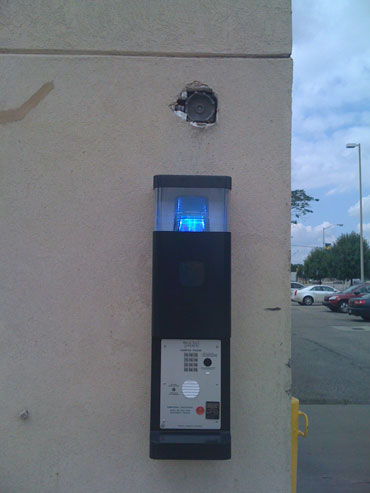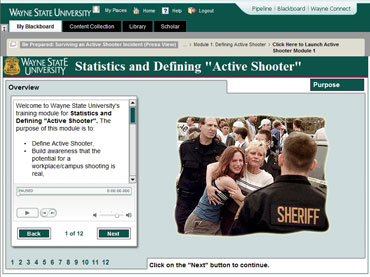Wayne State Teaches Students How To Stay Safe in Campus Shootings
- By Dian Schaffhauser
- 08/14/09
Following the April 2007 shootings at Virginia Tech, many institutions of higher education put student safety at the forefront to assure both parents and the campus community that they were doing all they could to prevent another such massacre. Wayne State University, a 30,000-student university in Detroit, MI, has taken many of the same steps--organizing a campus crisis team, implementing emergency notification, developing a communication plan.
But it's also about to take another step that most institutions haven't: launching an online training program to teach students, faculty, and staff how to stay safe in an active shooter situation. Among the instructions: what to do if the student hears a gunshot in the building; what to do if a shooter comes into the classroom; what to do if somebody is injured.
A Drill Too Real
The call for the training came out of a 2007 active shooter drill on campus that involved hundreds of people.
According to Wayne State Police Chief Anthony Holt, the 2007 shootings were a wake-up call. "Everybody looked at that and asked, 'Could that same situation occur here?' If so, how could we respond? Calling on a SWAT team from outside is outdated. You don't want to sit there and wait 40 minutes for another unit to be called in while you have collateral damage being done, when you have an active shooter running around taking out lives."
As part of that response, his department of 54 police officers bolstered its armory with weapons, acquired body armor and extraction tools, and went through extensive training to respond directly to a campus shooter.
"We developed it on the concept that we might have 10 patrol officers working a shift. If we had a shooter, those officers could get together as a react team to rendezvous, pull out the weapons, put on heavy body armor, and go in and neutralize that shooter," Holt explained.
In August 2007, the drill took place, which included the participation of the Detroit Police Department, the Wayne County Sheriff's Department, local hospitals and fire departments, 300 volunteer students--some of whom were made up by the university's theater department to show various stages of injuries--and another 200 to 300 volunteers to form an on-call crowd. According to Holt, the drill team populated a four-story classroom building on campus with students and told them they were part of a re-enactment of an active shooter. Then shooters went through the building firing off blanks.
As Holt described in bullet-point fashion, "We set up a central command post. Had the emergency. The officers followed their training, put on armor. The first team went in, neutralized the shooter. The second team went in to escort students out. The third team went in to search the building, floor to floor, room to room, to make sure it was only one shooter. During the exercise, another shooter had barricaded himself in. That situation was neutralized. The injured students were taken out by a second evacuation team and moved to a triage area we had set up. They were treated and transported to the hospital. In a final stage, the university brought in counselors to talk to students. This was supposed to be part of the exercise.
The problem, he said, was that the entire exercise was so realistic, somewhere along the way, the students forgot it was an exercise. The counselors were needed. "They were very heated," he added. "Officers had come in and walked past them even though they were begging for help. Then we explained that we needed to neutralize that shooter so no one else would get shot, that those officers walking past let the second team know where [the students] were, and they got [them] out."
That sense of verisimilitude was shared by the campus administration too.
"The people who participated forgot that it was not real," said Andrea Roumell Dickson, Wayne State's executive vice president, chief of staff, and the person charged with implementing the crisis management plan. "The day of the drill, the call came into me and the person said, 'We have an active shooter on campus.' And I said, 'OK.' At that point, I went into the mode as if it were real. I assembled the cabinet. I went along with some of the other cabinet members that were part of the crisis management team to the command center. We went to debriefings with the other responders--all the police officers and responding units."
Fallout from the Drill
Following the drill, the crisis management team--which includes Dickson, as well as the dean of students, the director of public safety, and representatives from the general counsel's office, housing, and counseling services--did a review and critique of the simulation.
Overall, the drill "went very well," said Dickson. "I don't want to be on the other end and make mistakes. The stakes are too high. There are things I'd rather find out during an exercise than find out afterwards."
For example, the drill exposed the fact that radios from the different first responder agencies didn't communicate. Now, the university police radios are on the same frequency as the Detroit Police Department and other public safety organizations in the state.
Wayne State also implemented an integrated campus safety project with several aspects.
Holt realized his police force needed the ability to block off portions of the campus. For this, the university is installing 30 PA systems and bluelight emergency phones from Ramtel. These will allow system administrators to specify the message and select which phones the message will be broadcast through and how often. "Now, I can send out an emergency broadcast, whether computerized or manually taking it over, 'We have a shooter. This building is closed. Do not enter this way,'" Holt explained.
Also, Wayne State will be installing cameras at those phones to provide the public safety department with exterior views of the campus. That will enable the police force to have a face-to-face conversation with the person using the phone and to view what's going on in the area. Cameras will also be installed in police cars, with the video feed going over the network. That will allow the team to do surveillance with fewer officers, said Holt. The cameras, which will be managed through software from Nice Systems, are expected to be in place by Sept. 1.

Access control gear will enable the university to lock down about 90 percent of campus buildings through a centralized console.
Active Shooter Training
But those new technologies didn't address the feedback from students that came out during the review, according to Holt. In effect, he said, they told campus police, "'Great. You took care of the shooters, but what about us? We need to know what to do.'"
That response led to the creation of the online course, "Be Prepared: Surviving an Active Shooter Incident." It was developed as a joint project involving people from public safety, Wayne State's TV department, the Computing & Information Technology organization, and the Human Resources' training division. The course is accessed through the campus' Blackboard system and consists of six modules, each between five and 20 minutes long.

The material is vivid and plain spoken, not softening the inherent violent nature of shooter incidents. In fact, the introduction states that some visitors may find the content "upsetting" or "disturbing." Viewers can listen to a narrator or scroll through the same explanation in text; the material can be delivered as a self-running slideshow or watched at the viewer's pace.
The advice offered in the training is simple. "If you hear a gunshot in the building, what do you do? Close the door. Put a table in front of the door. Pick a corner, not a window. Take cover in that room," said Holt. "If you're outside, look at your terrain. Do you have cement pillars? Take cover behind that area. Everything we do here is geared to make students safe."
He said although he'd like to make the course a part of mandatory training, Holt knows that's a tough sell on a university campus. So his plans are to tackle the job piecemeal. The course will launch during the freshman orientation "because that's a captive audience." After that, it will be rolled out through the residential population--3,000 to 5,000 students who are living on campus--through "floor sessions" in the dorms. From there, it will fan out throughout the rest of the campus community. Holt hopes to entice students by "prizing" them to attend town hall meetings where the course will be introduced. He also intends to communicate to department heads--who will, in turn, get the message about the video out to faculty--as well as university unions.
The university is also in the process of getting the material copyrighted, in the event that others--institutions of higher ed, government agencies, or private industry--express an interest in licensing it for their organizations.
"When we go to parent [events], we should not be the most popular section in the orientation," Holt concluded. "It should be about financial aid, about social things. But the parents want to know, 'I'm sending my son or daughter into this urban campus. We know what the crime rate is in Detroit. We want to know, could it happen here? We want to know, what do we tell our son or daughter if something like this happens?'"